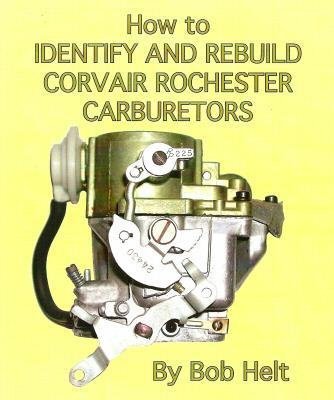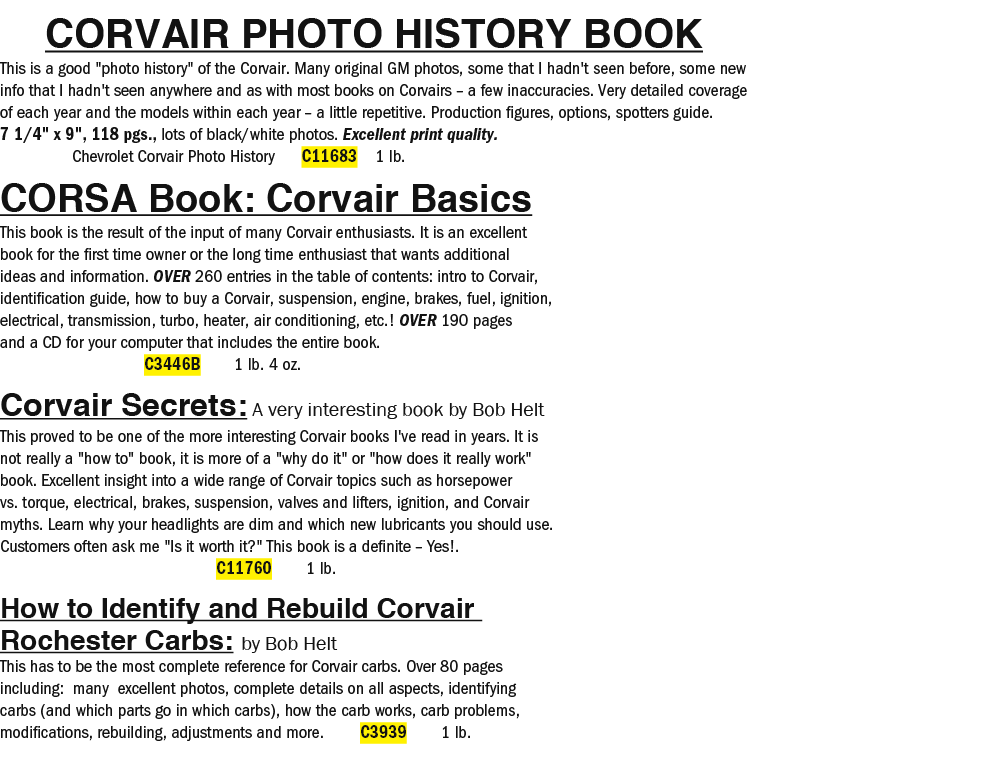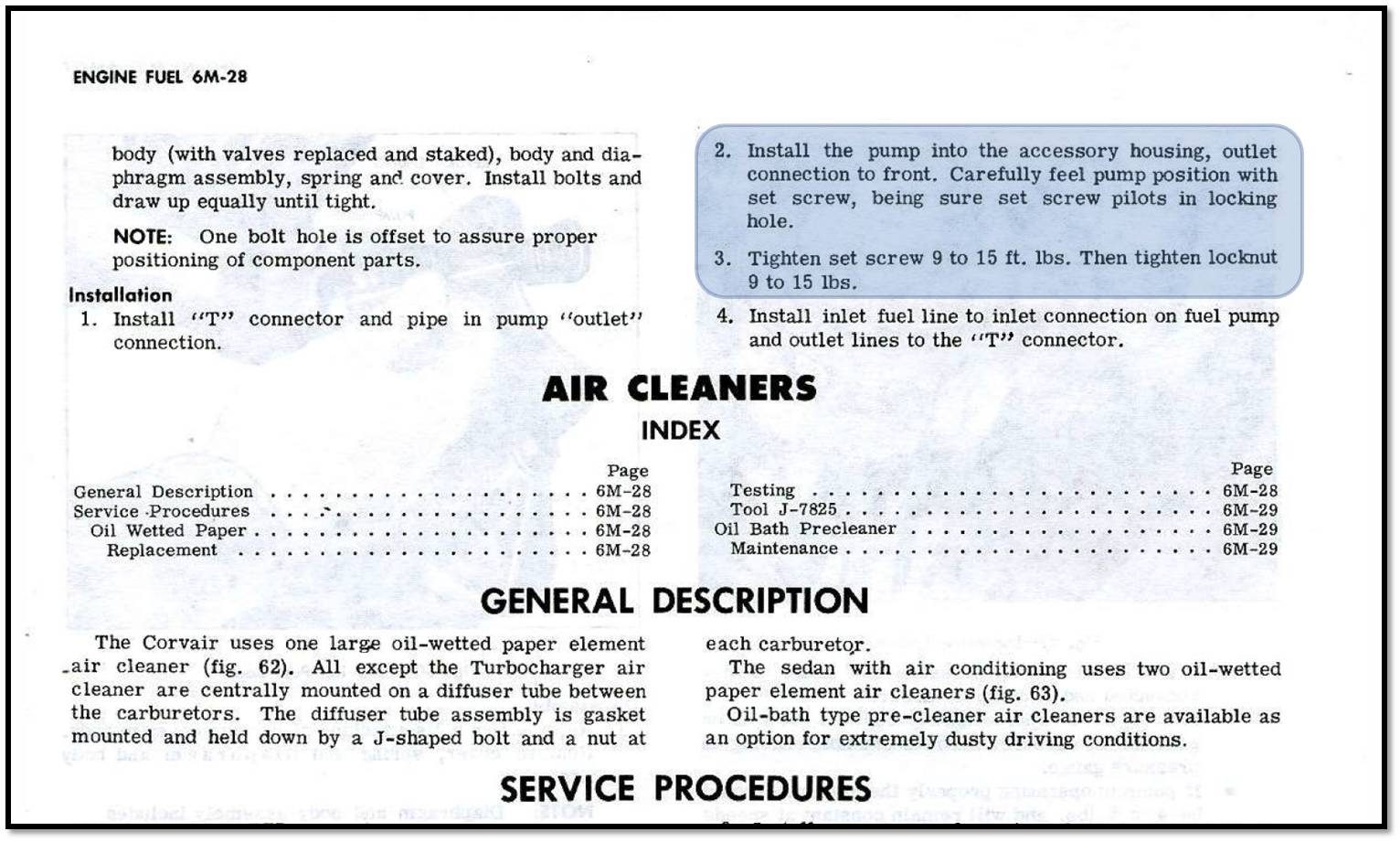Rochester H Carb question, 65 Corsa
Rochester H Carb question, 65 Corsa
On the float pivot, is there supposed to be a spring on the pin that pivots the floats? I don't see one in the shop manual.
Did someone add this? Is it necessary?
Joe
Did someone add this? Is it necessary?
Joe
- 66corsaguy
- Posts: 256
- Joined: Sat Apr 01, 2017 10:34 pm
-
joelsplace
- Posts: 2009
- Joined: Wed Oct 13, 2010 12:51 pm
- Location: Northlake, TX
Re: Rochester H Carb question, 65 Corsa
Early carburetors used larger floats and no spring later carbs used smaller floats and a spring. The floats that need a spring have a hole in the float arm the tip of the spring fits in.
157 Corvairs, 5 Ultravans and counting
Northlake, TX
Northlake, TX
-
WinginEngineer
- Posts: 150
- Joined: Sat Sep 03, 2016 3:31 pm
Re: Rochester H Carb question, 65 Corsa
My '62 has springs on the floats.
If yours has the hole on the float arm for the spring as mentioned above, and you get springs for it, make sure when you adjust the float level that the spring is on. It makes a difference :)
If yours has the hole on the float arm for the spring as mentioned above, and you get springs for it, make sure when you adjust the float level that the spring is on. It makes a difference :)
Kevin - Phoenix/Mesa, AZ
1962 Corvair 700
1962 Corvair 700
- bbodie52
- Corvair of the Month

- Posts: 11897
- Joined: Mon Aug 06, 2012 12:33 pm
- Location: Lake Chatuge Hayesville, NC
- Contact:
Re: Rochester H Carb question, 65 Corsa
FLOAT ASSIST SPRING
Highly recommended...


 http://www.corvair.com/user-cgi/catalog ... w_page=245
http://www.corvair.com/user-cgi/catalog ... w_page=245

Part number C3939: BOOK-CARBS BY BOB HELT
Weight: 1 lbs 0 oz
Catalog Page(s): 251
Price: $ 29.30
From Page 3 of the attached DELCO ROCHESTER - Models H, HV Carburetor Service GuideThe 1964 and later Model HV carburetors use a torsion spring to increase the holding power of the float needle against the float needle seat. The float assist spring was added to maintain a constant fuel level during extreme rough road operation. Changes in the float pontoons and hanger were necessary with the addition of the torsion assist spring. The float torsion assist spring should not be used on earlier models as float settings and float levels differ.
Highly recommended...



Part number C3939: BOOK-CARBS BY BOB HELT
Weight: 1 lbs 0 oz
Catalog Page(s): 251
Price: $ 29.30
- Attachments
-
- DELCO ROCHESTER - Models H, HV Carburetor Service Guide.pdf
- DELCO ROCHESTER - Models H, HV Carburetor Service Guide
- (1.79 MiB) Downloaded 31 times
Brad Bodie
Lake Chatuge, North Carolina
 1966 Corvair Corsa Convertible
1966 Corvair Corsa Convertible
Lake Chatuge, North Carolina
 1966 Corvair Corsa Convertible
1966 Corvair Corsa ConvertibleRe: Rochester H Carb question, 65 Corsa
The smaller float and helper spring were were used to prevent float bouncing on rough roads per GM. They were first used on the 1964 carburetors. You can use the "later" floats and springs in the earlier carburetors. Note the springs do wear at the float arm hole and sometimes break.
Note the spring has NO impact on float adjustments which is determined by the float stop for drop distance and the valve for closure distance.
Re: Rochester H Carb question, 65 Corsa
I had a fuel starvation problem and found that the spring was not allowing the float to drop hardly at all and the bowl was running dry. Adjusting the spring a little to allow a 1 3/4" drop seems to have helped a lot.
- bbodie52
- Corvair of the Month

- Posts: 11897
- Joined: Mon Aug 06, 2012 12:33 pm
- Location: Lake Chatuge Hayesville, NC
- Contact:
Re: Rochester H Carb question, 65 Corsa
It is hard to see how that damping spring could prevent the float from dropping to permit fuel to enter the float bowl.
bbodie52 wrote:The pump push rod is driven by a cam lobe on the crankshaft. The repeated "upstroke" causes the pump to form a vacuum in the feed line from the fuel source (tank or gas can). As the fuel is drawn into the pump chamber, the one-way valve in the pump inlet closes at the top of the stroke, and the spring in the pump forces the diaphragm back down to push the fuel out of the pump through the other one-way valve, toward the carburetors. The spring tension determines the fuel pump outlet pressure.
Check to make sure you are fully inserting the pump so that the pushrod driving the pump gets a full stroke to drive the fuel pump. Proper installation of the new parts is critical,,,
Also...To remove and reinstall the fuel pump, be sure that you have installed it properly. It is important to ensure that the fuel pump is correctly seated and installed. There is a hole in the side of the pump shaft that the tapered bolt tip must seat into. If the pump is sitting too high and the bolt is simply pressing against the side of the pump housing, rather than seating inside the tapered hole, the pump push rod will not be doing its job. Fig. 57 in the shop manual page shows the tapered hole that the tip of the bolt fits into. This ensures proper installation and seating of the pump.

For a quick check on fuel availability in the carburetors, you can peer down the throat of each carburetor while holding the choke open. Open the throttle quickly. You should see a squirt of fuel injected into the carburetor throat from the accelerator pump. This confirms the presence of fuel in each float bowl.There are two relatively simple tests outlined in the Corvair shop manual. These tests measure output pressure and fuel delivery volume. The output pressure test utilizes a common vacuum/pressure gauge that is relatively inexpensive. The output pressure is regulated by an internal spring that is contained in the upper pump housing. Unless your pump springs a leak in one of the diaphragms or seals, it is likely that the output pressure will not change with age. However, new pumps may be fitted with a spring that produces an output pressure well in excess of the 4-5 psi standard. High-pressure can cause carburetor flooding, and is particularly a problem with the Carter YH carburetor found on turbocharged Corvairs, which is sensitive to excessive fuel pressure.
A new fuel pump should always be tested for output pressure. If the pressure is found to be excessive it may be possible to cut the spring or to exchange the spring from the old pump and fit it into the new pump. This may correct the output pressure.
The second test measures fuel flow at the fuel pump outlet. The standard in the shop manual states that the pump should be able to deliver 1 pint of fuel over a period of 40 seconds or less at engine cranking speed. If your pump does not appear to have any leaks and can pass the output pressure test, but fails to deliver the needed fuel volume, the problem may not be with the pump itself. There is a long fuel line that runs the length of the car from the fuel tank to the fuel pump. In order to pressurize and deliver fuel to the carburetors, the pump must be able to create a continuous vacuum in that fuel line to draw the fuel from the tank to the pump. Most of the fuel line is made up of steel tubing and is unlikely to develop a leak. However, there are two short lengths of rubber fuel hose in the fuel path. One section of hose is found at the fuel tank outlet, while the other is found adjacent to the starter motor — just before the line enters the engine compartment. The purpose of the second hose is to absorb vibration from the engine and prevent it from reaching the rigid steel fuel line. If either one of these two hoses develops a leak, the leak itself may not be apparent because the line is not under pressure so fuel will not be forced out. Instead, the leak amounts to a vacuum leak, which can allow air to enter the fuel line. This can prevent fuel from being drawn from the tank to the fuel pump, much like you might experience with a drinking straw if the straw was to split and developed an air leak in the side of the straw. What appears to be a faulty pump that is causing fuel starvation problems in the carburetors often turns out to be a leak in the fuel line at some point between the gas tank and the fuel pump. So if fuel starvation becomes a problem with your carburetors, there is a tendency to question the condition of the needle and seat valve inside the carburetor, or to blame the fuel filter at the carburetor inlet (thinking it is clogged), or to blame the fuel pump itself. Before you blame the pump and toss it, or abandon it and replace it with electric fuel pump, be sure to check the condition of the rubber fuel hoses at each end of the long fuel line between the fuel tank and the fuel pump. You may find that a couple of hose clamps and a few inches of replacement fuel hose is all that necessary to get you back on the road!
With the air cleaner assembly removed, when holding the choke open and peering down the throat of each carburetor, do you see a squirt of fuel from the accelerator pump in each carburetor when you open the throttle rapidly? If the jet of fuel is not observed, the float bowls may be dry, possibly due to stuck needle and seat assemblies blocking the fuel inlet.
Brad Bodie
Lake Chatuge, North Carolina
 1966 Corvair Corsa Convertible
1966 Corvair Corsa Convertible
Lake Chatuge, North Carolina
 1966 Corvair Corsa Convertible
1966 Corvair Corsa ConvertibleRe: Rochester H Carb question, 65 Corsa
Yes the new replacement springs tend to have too much tension. The old ones do rub and eventually break so folks install the new replacements from Clark's and the tension sometimes needs to be adjusted. Aftermarket parts - sighhhh.
The original springs just allow the float to fall to the adjustment drop stop at least based on my experience.
BTW - It is a good practice to verify the fuel pump pressure as this impacts the fuel bowl levels.